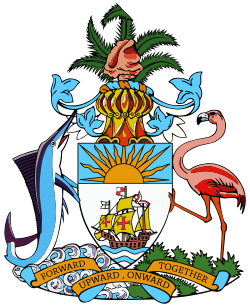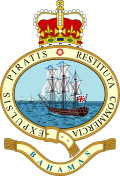Coat of arms of the Bahamas
| Coat of arms of the Bahamas | |
|---|---|
 | |
| Armiger | Commonwealth of The Bahamas |
| Adopted | 7 December 1971 |
| Crest | Upon a representation of Our Royal Helmet mantled Azure doubled Argent on a Wreath Or and Azure. A Conch Shell proper in front of a Panache of Palm Fronds proper.[1] |
| Torse | Orange and Azure |
| Shield | Upon a representation of the Santa Maria on a base barry wavy of four Azure and Argent on a Chief Azure demi-sun Or. |
| Supporters | On the dexter side a Marlin proper and on the sinister side a Flamingo proper |
| Compartment | Per pale Waves of the Sea and Swampland proper. |
| Motto | Forward, Upward, Onward Together |

The coat of arms of the Bahamas contains a shield with the national symbols as its focal point.
Official description
[edit]The blazon of the coat of arms is described in Bahamas law:[2]
Arms: Upon a representation of the Santa Maria on a base barry wavy of four Azure and Argent on a Chief Azure demisun Or.
Crest: Upon a representation of Our Royal Helmet mantled Azure doubled Argent on a Wreath Or and Azure. A Conch Shell proper in front of a Panache of Palm Fronds proper.
Supporters: On the dexter side a Marlin proper and on the sinister side a Flamingo proper; and upon a Compartment per pale Waves of the Sea and Swampland proper.
Motto: “Forward, Upward, Onward Together”.
Explanation
[edit]The escutcheon (shield) is supported by a marlin and flamingo. The crest on top of the helm (helmet) is a conch shell, which represents the varied marine life of the island chain. Below the helm is the escutcheon itself, whose main charge is a ship, reputed to represent the Santa María of Christopher Columbus. It is sailing beneath a sun in the chief. The animals supporting the shield are the national animals, and the national motto is found at the bottom. The flamingo is located upon land, and the marlin upon sea, indicating the geography of the islands.
The vibrant tinctures of the coat of arms are also intended to point to a bright future for the islands. They are also reputed to have been maintained for their attractiveness to tourists.
The coat of arms was approved by Queen Elizabeth II on 7 December 1971. It was designed by Bahamian artist and clergyman Dr. Hervis L. Bain, Jr., who is also a member of the Order of the British Empire.
History
[edit]| Crown Colony of the Bahamas | ||
| Emblem | Period of use | Notes |
|---|---|---|

|
1869–1904; 1953-1964 | Colonial badge of the Bahamas. Depicting a British ship chasing two pirate ships out at the high seas and the motto "Expulsis piratis restituta commercia" (Pirates expelled, commerce restored) |

|
1904–1953 | The coat of arms remained the same but the crown was changed to a Tudor Crown. |

|
1964–1973 | On 1964, the coat of arms was changed to a higher detailed version with the "Bahamas" text colour changing to blue and a Tudor rose between the motto. |
Island arms
[edit]In addition to the National Coat of Arms, there are a total of eighteen regional island shields (including two unofficial devices). These were granted upon Independence in 1973, to be displayed at the Independence day celebration to reflect each island's individual cultural heritage.
Island arms of the Commonwealth of the Bahamas
| ||||||||
| Acklins | Abaco | Andros | Berry Islands | |||||
| Bimini | Cat Island | Crooked Island | Eleuthera | |||||
| Grand Bahama | Inagua | Long Island | Mayaguana | |||||
| New Providence | Ragged Island | Rum Cay | San Salvador | |||||
References
[edit]- ^ "Flags and Coat of Arms (Regulation)" (PDF). Bahamas Legislation ch. 32. Archived from the original (PDF) on 27 December 2021. Retrieved 20 April 2018.
- ^ "FLAGS AND COAT OF ARMS (REGULATION)" (PDF). Archived from the original (PDF) on 2021-12-27. Retrieved 2018-04-20.
